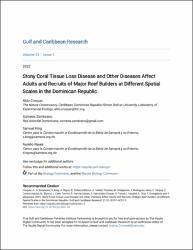| License | This Gulf and Caribbean Fisheries Institute Partnership is brought to you for free and open access by The Aquila Digital Community | es |
| Author | Cróquer, Aldo | |
| Author | Zambrano, Someira | |
| Author | King Pérez, Samuel A. | |
| Author | Reyes, Aurelio | |
| Author | Sellares-Blasco, Rita I. | |
| Author | Valdez Trinidad, Andreína | |
| Author | Villalpando, María F. | |
| Author | Rodríguez-Jerez, Yira | |
| Author | Cortés-Useche, Camilo | |
| Author | Blanco, Macarena | |
| Author | Calle-Triviño, Johanna | |
| Author | García-Camps, Rebecca | |
| Author | Hernández-Oquet, Ana Carolina | |
| Author | Torres, Rubén E. | |
| Author | Irazabal, Iker | |
| Author | Díaz, Laura | |
| Author | Evangelista, Yassmin | |
| Author | Miyazawa, Emy | |
| Accessioned date | 2022-06-13T15:29:10Z | |
| Available date | 2022-06-13T15:29:10Z | |
| Year | 2022 | |
| Citation | Cróquer, A., Zambrano, S., King, S., Reyes, A., Sellares-Blanco, R., Valdez Trinidad, A., ... & Miyazawa, E. (2022). Stony coral tissue loss disease and other diseases affect adults and recruits of major reef builders at different spatial scales in the Dominican Republic. Gulf and Caribbean Research, 33(1), GCFI1-GCFI13. Recuperado de: | es |
| URI | https://bvearmb.do/handle/123456789/1059 | |
| Abstract | Monitoring programs can help understand coral disease dynamics. Here, we present results from a national program in the Dominican Republic (DR) aimed at evaluating coral diseases 3 times a year following a nested spatial design. Prevalence of coral diseases in DR varied from sites to regions, suggesting that disease dynamics can be driven by local processes and/or across larger spatial scales. Three diseases were common: Dark Spot (DSD), Yellow Band (YBD) and Stony Coral Tissue Loss Disease (SCTLD). DSD and YBD were more prevalent across the western coast (north and south), whereas SCTLD was restricted for the study period to the northern coast. SCTLD has become endemic in the northwestern coast, epizootic in the northeastern, and absent in other sites across DR. SCTLD prevalence in the northwest was below 10% across sites, whereas in the northeast it varied from 2.13±3.69% (mean± sd) to 38.7±13.55% in Galeras and from 1.9±0.99% to 38.5±19.8% in Samaná. Over 10 coral species were affected by SCTLD in DR, with Pseudodiploria spp, Dendrogyra cylindrus, Eusmilia fastigiata, Siderastrea siderea, Montastraea cavernosa and Meandrina spp, being the most susceptible. We observed SCTLD affecting recruits and juvenile corals with 5% prevalence on average. Furthermore, we observed Oreaster reticulatus climbing on 1% healthy and 27% SCTLD P. strigosa colonies in Samaná. We conclude that SCTLD is a serious problem in DR, producing rapid loss of coral cover of major reef builders that are locally used for propagation efforts. This monitoring plan will provide future insights to design more effective disease responses. | es |
| Language | English | es |
| Published | Gulf and Caribbean Research, 33(1), GCFI1-GCFI13 | es |
| Rights | © The Aquila Digital Community | es |
| Subject | Hábitats y especies | es |
| Subject | Arrecifes de coral | es |
| Title | Stony coral tissue loss disease and other diseases affect adults and recruits of major reef builders at different spatial scales in the Dominican Republic | es |
| dc.identifier.doi | 10.18785/gcr.3301.03 | |
| Material type | Article | es |
| Type of content | Scientific research | es |
| Access | Open | es |
| Audience | Technicians, professionals and scientists | es |


